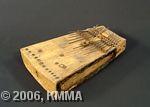


Alternative names: likembe, kasayi, sansa, akadongo k’abaluru
The ikembe is classified as a lamellaphone and consists of a series of iron lamellae, fixed to a rectangular wooden soundbox. In Burundi the ikembe was not introduced until the beginning of the twentieth century, during the Belgian colonisation period, and originated from the former Belgian Congo. Different versions and names of the instrument exist in large parts of Africa. The type played in Rwanda is known as the ‘fluvial type’ because it originates from the major river areas in the Congo. Two peoples ensured its propagation: the Kongo and the Bangala, who played the instrument to accompany their own solo singing.
The fluvial type exists in two forms: pointed, in which the top of the soundbox is pointed and the bottom is hollow, and round, in which the top is rounded and the bottom is flat. Both are made in the same way and are about the same size (23-40 cm by 12-19 cm). The soundbox is formed by hollowing out a soft rectangular block of wood from the side. This is later covered with a strip of wood and sealed with resin, rubber or honey. Before this opening is covered up a few seeds or pebbles are placed in the instrument to provide an additional source of sound. A few sound holes are also bored; covering these enables the timbre to be varied. Iron lamellae (imirya) – sometimes the flattened spokes of a bicycle wheel – are then fixed to the soundbox. Their number varies between eight and twelve, and is preferably ten or eleven. They are divided into two groups, with each hand spanning nearly the full range; the notes are not placed in a single series of rising tones, but in two parallel series that cover more or less the same range. The lamellae are fixed using three transverse bridges, the outer two serving as supports while the central bridge pushes the lamellae down, holding them in place. The rings attached between the bridges and around the lamellae are another contributory sound element.
The ikembe is made by the Twa and is mainly played by the Twa and the Hutu. A singer usually accompanies himself on the ikembe, but it can also be played together with other instruments as part of either a duet or even a trio. In the last example one of the performers plays a continuous note as the bass accompaniment to the melody (bourdon).
Depending on the scale required, the lamellae are made longer or shorter in order to obtain a different pitch. An anhemitonic pentatonic scale is generally used.
The songs that are accompanied by the ikembe are either entertaining tales set to music, songs of praise to figures of authority or expressions of personal feelings. Occasionally historical and traditional themes are set to music, but these are mainly based on texts of songs that are accompanied by the inanga.
The ikembe duplicates the melody, in that the singer sings and plays the same melody at the same time, but the instrument can also imitate and echo the melody. In addition, there is always an instrumental prelude, interlude and epilogue without any singing. The melodic line, both vocal and instrumental, tends to descend.
For more information consult the following publications edited by the RMCA:
© KMMA/Jos GANSEMANS